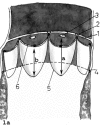Origins of the coronary arteries and their significance
- PMID: 20126349
- PMCID: PMC2815286
- DOI: 10.1590/S1807-59322010000100012
Origins of the coronary arteries and their significance
Abstract
Objective: To describe the normal and variant anatomy of the coronary artery ostia in Indian subjects.
Introduction: Anomalous coronary origins may cause potentially dangerous symptoms, and even sudden death during strenuous activity. A cadaveric study in an unsuspected population provides a basis for understanding the normal variants, which may facilitate determination of the prevalence of anomalies and evaluation of the value of screening for such anomalies.
Methods: One hundred and five heart specimens were dissected. The number of ostia and their positions within the respective sinuses were observed. Vertical and circumferential deviations of the ostia were observed. The heights of the cusps and the ostia from the bottom of the sinus were measured.
Results: No openings were present in the pulmonary artery or the non-coronary sinus. The number of openings in the aortic sinuses varied from 2-5 in the present series; multiple ostia were mostly seen in the anterior sinus. The majority of the ostia lay below the sinutubular ridge (89%) and at or above the level of the upper margin of the cusps (84%). Left ostial openings were mainly centrally located (80%), whereas the right coronary ostia were often shifted towards the right posterior aortic sinus (59%).
Discussion: The preferential location of the ostia was within the sinus and above the cusps, but below the sinutubular ridge. On occasion, normal variants like multiple ostia, vertical or circumferential shift in the position, and slit-like ostia may create confusion in interpreting the images and pose a difficulty during procedures like angiography, angioplasty, and coronary artery bypass grafting.
Keywords: Aortic cusps; Aortic sinuses; Commissures; Coronary ostium; Sinutubular ridge.
Figures







Similar articles
-
Anatomical and radiological angiographic study of the coronary ostia in the adult human hearts and their clinical significance.Anat Cell Biol. 2018 Sep;51(3):164-173. doi: 10.5115/acb.2018.51.3.164. Epub 2018 Sep 28. Anat Cell Biol. 2018. PMID: 30310708 Free PMC article.
-
The positions of coronary arterial ostia.Clin Anat. 1996;9(6):376-80. doi: 10.1002/(SICI)1098-2353(1996)9:6<376::AID-CA3>3.0.CO;2-9. Clin Anat. 1996. PMID: 8915616
-
Morphometric and topographic study of coronary ostia.Arq Bras Cardiol. 2003 Oct;81(4):359-62, 355-8. doi: 10.1590/s0066-782x2003001200003. Epub 2003 Nov 5. Arq Bras Cardiol. 2003. PMID: 14666278 English, Portuguese.
-
Anomalous origin of the entire coronary system with separate ostia within the right sinus of valsalva: a rare congenital anomaly and a review of the literature.Cardiology. 2007;107(3):209-12. doi: 10.1159/000095419. Epub 2006 Aug 23. Cardiology. 2007. PMID: 16946599 Review.
-
Clinical profile of congenital coronary artery anomalies with origin from the wrong aortic sinus leading to sudden death in young competitive athletes.J Am Coll Cardiol. 2000 May;35(6):1493-501. doi: 10.1016/s0735-1097(00)00566-0. J Am Coll Cardiol. 2000. PMID: 10807452 Review.
Cited by
-
Anatomical and radiological angiographic study of the coronary ostia in the adult human hearts and their clinical significance.Anat Cell Biol. 2018 Sep;51(3):164-173. doi: 10.5115/acb.2018.51.3.164. Epub 2018 Sep 28. Anat Cell Biol. 2018. PMID: 30310708 Free PMC article.
-
Incidental finding of double aortic arch and tract from noncoronary sinus to left atrium: A case report.Radiol Case Rep. 2023 Nov 2;19(1):254-259. doi: 10.1016/j.radcr.2023.10.012. eCollection 2024 Jan. Radiol Case Rep. 2023. PMID: 38028280 Free PMC article.
-
Narrative Review of Anomalous Origin of Coronary Arteries: Pathophysiology, Management, and Treatment.Curr Cardiol Rev. 2023;19(6):50-55. doi: 10.2174/1573403X19666230530095341. Curr Cardiol Rev. 2023. PMID: 37259216 Free PMC article. Review.
-
Intraoperative Transesophageal Echocardiography for Coronary Artery Assessment.Circ Rep. 2020 Aug 4;2(9):517-525. doi: 10.1253/circrep.CR-20-0063. Circ Rep. 2020. PMID: 33693277 Free PMC article.
-
Eisenmenger syndrome with left main compression syndrome: a case report.BMC Cardiovasc Disord. 2022 Mar 5;22(1):89. doi: 10.1186/s12872-022-02524-w. BMC Cardiovasc Disord. 2022. PMID: 35247981 Free PMC article.
References
-
- Vlodaver Z, Neufeld HN, Edwards JE. Coronary arterial variations in the normal heart and in congenital heart disease. New York: Academic Press; 1975. pp. 19–22.
-
- Standring S, Ellis H, Healy JC, Jhonson D, Williams A, Collins P, et al. Gray’s Anatomy –The Anatomical Basis of Clinical Practice. 39th Ed. London: Churchill Livingstone; 2005. Heart and great vessels; pp. 1008–17.
-
- Steinberger J, Lucas RV, Jr, Edwards JE, Titus JL. Causes of sudden unexpected cardiac death in the first two decades of life. Am J Cardiol. 1996;77:992–5. - PubMed
-
- Frescura C, Basso C, Thiene G, Corrado D, Pennelli T, Angelini A, et al. Anomalous origin of coronary arteries and risk of sudden death: A study based on an autopsy population of congenital heart disease. Hum Pathol. 1998;29:689–95. - PubMed
-
- Basso C, Maron BJ, Corrado D, Thiene G. Clinical profile of congenital coronary anomalies with origin from the wrong aortic sinus leading to sudden death in young competitive athletes. J Am Coll Cardiol. 2000;35:1493–501. - PubMed
MeSH terms
LinkOut - more resources
Full Text Sources

